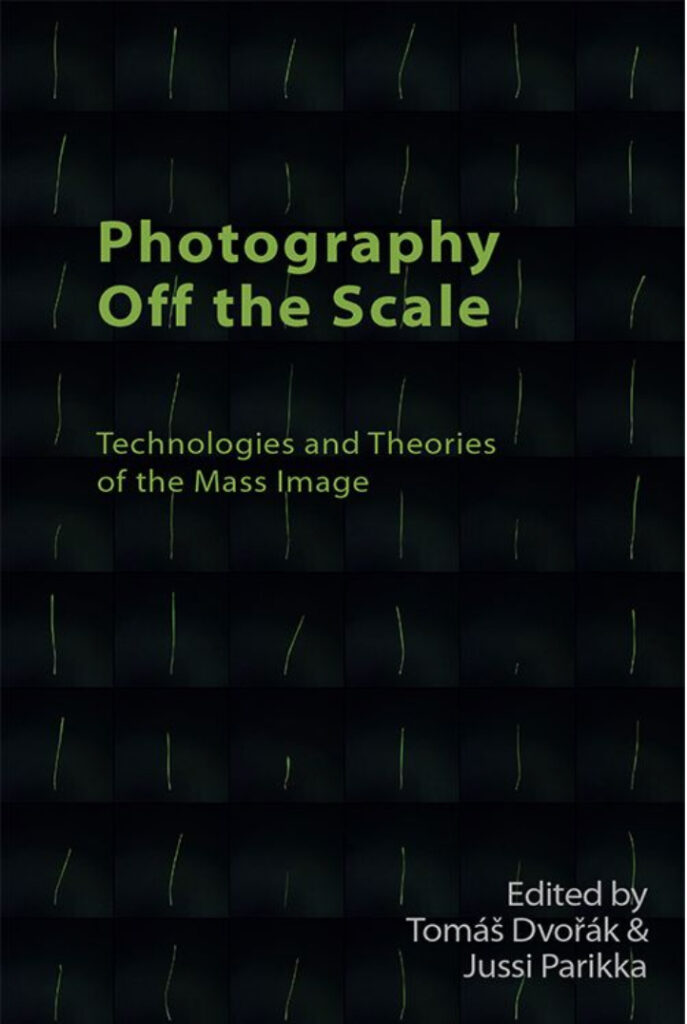Book review: Photography Off the Scale: Technologies and Theories of the Mass Image
Article DOI: https://dx.doi.org/10.15180/211609
Keywords
digital culture, media studies, operational images, science and technology studies (STS), visual arts, visual culture
There is a certain, increasingly prevalent type of Tweet in which a person asks for advice on how to archive the many, many photographs that are clogging up the storage space on their phone. Each time I see this Tweet, the number of gigabytes has increased spectacularly: 10GB; 30GB; 200GB; 700GB. We have never before had so many images saturate our lives.
Enter Photography Off the Scale, an edited volume which takes this saturation as its focus. Here is a flabbergasting figure noted by Tomáš Dvořák and Jussi Parikka in their introduction: on Snapchat alone, more than 800 million photos are shared every single day. Numbers of such mind-boggling magnitudes as this are dotted throughout the diverse essays in this book. Its contributors hail from various disciplines, including art history, data visualisation, design, screen studies, new media, and philosophy of technology. To be clear, this multidisciplinarity is no mere contrivance. Rather, it is demanded by the book’s subject matter and central to its argument: underpinning the collection as a whole is the notion that this saturation, or abyss, of images plagues all corners of contemporary life. And therefore we must survey the abyss from diverse vantage points.

But what would the abyss look like, exactly? How big is 800 million? This is the question Dvořák takes up in his chapter. How can we ‘translate that which is beyond all mensuration into our quotidian earthbound world of limited faculties’? How can we ‘place the gigantic into some sort of comprehensible perspective’? Dvořák’s argument, essentially, is that we can’t. When we try to make sense of massive numbers we face only marginally smaller massive numbers. Take, for instance, the 11 billion tons of surface ice lost in Greenland on a single day in 2019. How can we make sense of this figure? We might try to convert it to that standard pop culture measure, the Olympic-size swimming pool. Doing so would present us with 4.4 million pools. ‘I somehow understand it is a huge amount and an irregular and alarming event,’ writes Dvořák, ‘however, I am not able to picture millions of Olympic swimming pools any better than billions of tonnes of ice.’
Whereas the scales in Dvořák’s chapter are impossible to imagine, Annebella Pollen’s chapter shows us exactly what an unmanageable excess of images looks like. She explores contemporary art installations that make use of deaccessioned slide libraries. Stark images accompany her essay: a sea of thousands of tiny photographic images, undulating piles stretching from wall to wall. Pollen notes that the slides, in their original pedagogical context, ‘were meant to convey controlled and detailed information’. But when relocated to the context of the gallery, ‘missing the proper meaning is the pursuit. Slides’ excess, in more ways than one, is what is wanted.’ Her chapter is a welcome reminder that photography was tipping off the scale even before the advent of digital images.
Elsewhere, Michelle Henning argues that social media photography operates in a similar way to conversational speech. She reminds us that with these vernacular photographs, shared instantaneously from person to person online, photography has expanded into a mass, daily practice for many people around the world.
Some of the other essays turn toward the less literally ‘photographic’. Lukáš Likavčan and Paul Heinicker use Dietmar Offenhuber’s concept of the ‘autographic’ to identify a particular type of image of the natural world: visible traces which derive from material phenomena. One example is tree rings. Likavčan and Heinicker argue that these autographic images, when interpreted, can provide different information to more conventional, representational images. The chapter focuses particularly on the possibilities offered by the autographic to image climate change, that most difficult-to-picture of natural phenomena.
Parikka himself considers ‘photographs’ that we can’t see: images created by machines, for machines. He argues that ‘photographic theory and history have had a tendency to focus more on seeing through things we call “cameras” instead of, for example, sensors’. He cites a recent paper which suggested WiFi antennae and signals are ‘in principle, sensors capable of detecting body postures and movement’, and thus that we might say that a type of WiFi image exists beyond the visual spectrum. One of Parikka’s most interesting ideas is about how in these ‘practices of light beyond photography […] the image gets entangled, even conflated, with its own sensors’. The point is powerful in part because it rings true beyond Parikka’s narrow subject matter: for instance, no one thinks of the CCTV camera without thinking of the image it produces.
By taking up marginal, under-explored ‘photographic’ subjects, this collection teases out an alternative genealogy of visual media. The history of photography’s shadow. (Perhaps ‘negative’ is the more apt term.) The book’s coda – correspondence between artist Joan Fontcuberta and art historian Geoffrey Batchen – is a welcome change of pace to the chapter-essay format of the other contributions. It also reframes the contributions that precede it, acting as a sort of inverse introduction. One could start here at the back of the book and read it the ‘wrong’ way, ending at the Introduction, and it would be a fulfilling experience. For Batchen, a major issue in the history of photography is its tendency to myopia, focusing as it does predominantly on canonical photographers and images. He wonders ‘what kind of history must be forged to properly represent photography’s complex identity’. Photography Off the Scale provides one answer to his question.



